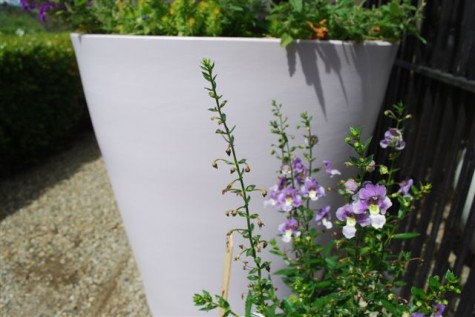
I hear too often from people that their pots peter out in August. There is no need for that, barring your dog unearthing them, or a hailstorm. I usually take my pots apart in November, as I am just plain tired of taking care of them. But here’s my formula for longevity through August and beyond. First off, water, and water properly-which can mean, water even when you don’t feel like it. This means soak your pots, and then let them get dryish before you water again. Secondly, deadhead regularly; do not let you annual flowers go to seed.
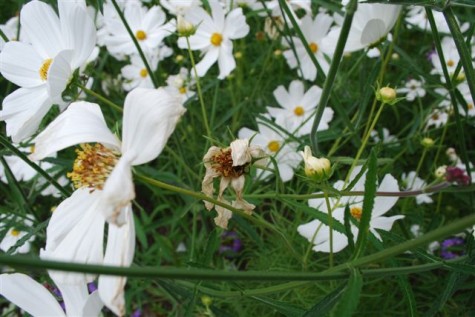
Here’s the biology behind the scenes. Annual plants by definition are plants that grow, flower, and set seed in one season. An annual which has successfully set seed has no biological reason to continue to flower. For those of you who think annuals bloom so the world will be a more beautiful place, here here. These plants flower for the purpose of reproduction-to insure the continuation of the species. If you prevent an annual from setting seed, it will continue to flower. There are plenty of flowers which are sterile, and do not set seed; they are popular for exactly this reason. Trailing verbena, on the other hand, will go out of flower quickly, if it is not deadheaded.
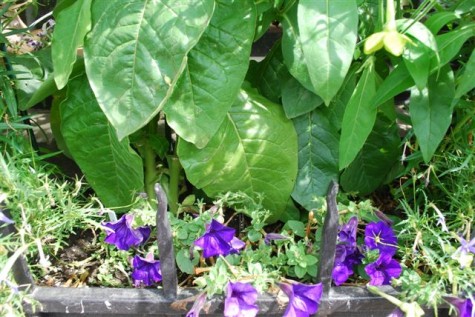 Plants grow in, and the room can get crowded. If the giant leaves of this nicotiana are allowed to shade the petunia, said petunia will pout, and finally give up. Removing leaves, or branches so everyone has a sunny spot, is good group management. A pot or window box is no place for a bully running amok. No one will like the result- least of all, you.
Plants grow in, and the room can get crowded. If the giant leaves of this nicotiana are allowed to shade the petunia, said petunia will pout, and finally give up. Removing leaves, or branches so everyone has a sunny spot, is good group management. A pot or window box is no place for a bully running amok. No one will like the result- least of all, you.
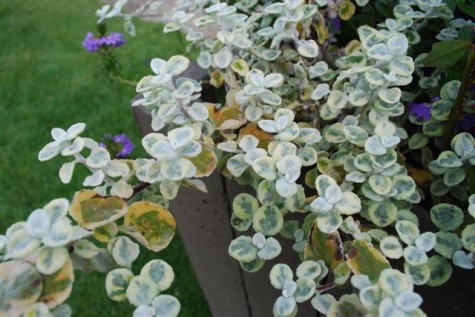 Try not to overwater. Put your finger down into the dirt. If the dirt sticks to you, there is probably enough moisture. Rotting leaves are unsightly. Worse yet, an environment that is too wet is an invitation to every fungus floating by, looking for a good home. Licorice likes dry conditions. Should you have been so bold to plant it next to an annual that loves water and more water, you’ve engineered a situation where individual plants in a community pot have to be watered on different schedules. This is not tough, just time-consuming.
Try not to overwater. Put your finger down into the dirt. If the dirt sticks to you, there is probably enough moisture. Rotting leaves are unsightly. Worse yet, an environment that is too wet is an invitation to every fungus floating by, looking for a good home. Licorice likes dry conditions. Should you have been so bold to plant it next to an annual that loves water and more water, you’ve engineered a situation where individual plants in a community pot have to be watered on different schedules. This is not tough, just time-consuming.
 Annuals need pruning, just like shrubs and trees. Pruning the flowers from your coleus plants result in densely growing coleus. Pruning plants at different heights gives everyone breathing room. Once a group of plants are put together in one pot, or one area, they take on a collective life. Sun, water and space have to be shared. And whatever the individual plants, you want an overall shape that looks great.
Annuals need pruning, just like shrubs and trees. Pruning the flowers from your coleus plants result in densely growing coleus. Pruning plants at different heights gives everyone breathing room. Once a group of plants are put together in one pot, or one area, they take on a collective life. Sun, water and space have to be shared. And whatever the individual plants, you want an overall shape that looks great. 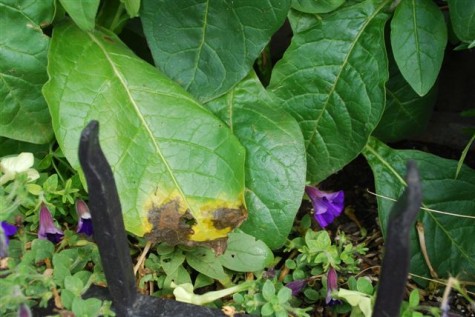
Plants that are healthy resist disease. Healthy means properly watered, fed, pruned and managed. If you do get a fungus, remove the diseased portions as soon as you can. Remove lower leaves in the interiors of your pots to promote good air circulation. Prevention is a lot easier that treatment. Sometimes weather conditions foster disease; I will spray with a fungicide if I have to. Safer’s soap will get rid of some insect pests-the trick is to apply 3 rounds, not one. Spider mites are notoriously difficult to get rid of. I avoid certain types of mandevilleas as they are so prone to them.
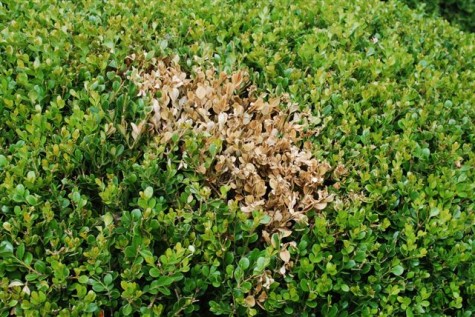 My beloved boxwood hedge was attacked this spring by a fungus called Volutella-I was beside myself over the damage. I had to get an expert to identify it for me; I have never seen this on boxwood before. We cleaned out, and raked up every dead leaf, and pruned out every infected branch with shears that were disinfected after each cut. Next spring I will spray for it. Imagine being a greenhouse grower-where plant illnesses and insects can threaten a livlihood. Most growers that I know practice close inspection of their plants, so they catch problems early. They also feed their plants; strong plants resist trouble. Once every seven to ten days I make sure my pots are thoroughly watered, then I liquid- feed them with a water soluble fertilizer with a big middle number (15-30-15) to encourage good flower production. This acts like a shot of vitamin B-12. Then I hold off watering as long as I can, so the plants take up the nutrients, before they get flushed out by the next round of watering.
My beloved boxwood hedge was attacked this spring by a fungus called Volutella-I was beside myself over the damage. I had to get an expert to identify it for me; I have never seen this on boxwood before. We cleaned out, and raked up every dead leaf, and pruned out every infected branch with shears that were disinfected after each cut. Next spring I will spray for it. Imagine being a greenhouse grower-where plant illnesses and insects can threaten a livlihood. Most growers that I know practice close inspection of their plants, so they catch problems early. They also feed their plants; strong plants resist trouble. Once every seven to ten days I make sure my pots are thoroughly watered, then I liquid- feed them with a water soluble fertilizer with a big middle number (15-30-15) to encourage good flower production. This acts like a shot of vitamin B-12. Then I hold off watering as long as I can, so the plants take up the nutrients, before they get flushed out by the next round of watering.
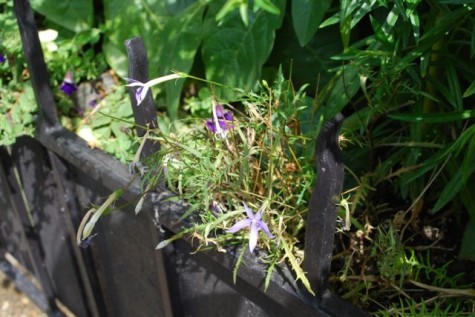
There will be those times when no amount of good growing practices and cultures will result in a good plant. Don’t be afraid to yank something that is clearly beyond rescue. Perfection applies only to diamonds and moments, remember?
Great post! I do most of these but it never hurts to hear it again. Thanks.
OK, I don’t always water when I don’t feel like it.
I also think knowing which annuals to prune is one of the hardest parts of this.
Deborah, thanks for the showing and telling how a
fungus can attack a plant and will kill it if not removed. I happen to have had it show up on one of
my hydrangea and I was so sad as it is my favorite shrub. I was quick to take a short limb to the nursery to find out what was going on. I bought the
spray and fertilizer and I will be anxious to see if
lots of attention will save the shrub. I was told to
remove every dead leaf in the flower bed. With doing
all that, it was much better to follow what you said.
Thanks from one who has much to learn. Mickey
Deborah, Terrible news about your boxwood hedge. I understand that a lot of the historic estates in England have had a horrible problem with this. Sir Roy Stong of The Laskett, had to rip out all of his boxwood and is in the process of changing them to yews.
I had thought, after the snow broke and battered my boxwood this winter, that was all I had to worry about!
It is amazing, after people get their urns planted up, that they think they are maintenance free!
Another great post!
Wonderful post! I stumbled it. Not hard here to remember to water the containers. It’s so blankin’ hot you can’t forget. The question is, are you brave enough to go out there? I’m sorry about your hedge.~~Dee
Dear Dee, I am so glad you stumbled onto my blog! I know the blanking I can’t stand it hot thing-which is no doubt less than a third of the hot you deal with. I’ve had several comments today, including yours, expressing regret about my boxwood fungal mess. How cool that I am making gardening friends that understand about landscape disaster. Many thanks, Deborah
Really nice posts. I will be checking back here regularly.
We’re you successful at treating the volutella? I had this happen to me last year however I had no idea what it was. I thought maybe I had burned them by pruning when it was too hot outside. Then this spring I discovered that a large one that I just bought And paid $150 for was the culprit. I’m both mad and sad that this new one is threatening the ones I’ve had for 9 years!! I’m considering destroying the new one unless you tell me it can be treated!
Dear Sherry, we were successful treating it. But it took three years. If you have a single plant that is infected, I would dispose of it. Do not compost it! best regards, Deborah